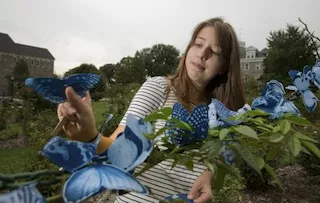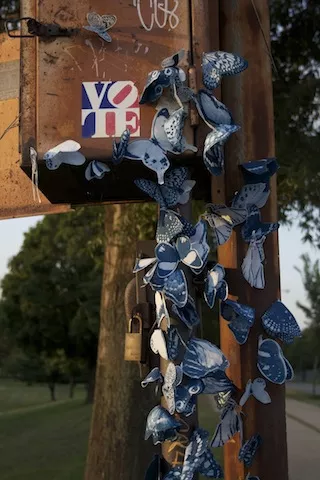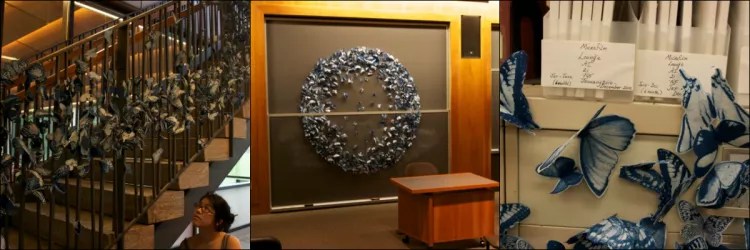Tasha Lewis '12 Brings Art to the Streets in Swarms

In an increasingly mobile and busied society, we rarely consider the mailbox on the corner, the aging statue in the courtyard, or the telephone pole racked with staples. Instead we find beauty where it is obvious and expected: in greenery, among the foliage, inside the walls of an art museum. But for Tasha Lewis '12, subversive forms of art can be just as aesthetically powerful by presenting the unpredictable. In her case, that unpredictability arrives on the wings of 400 butterflies.
The sculptor's swarms, which have landed on familiar places in Indianapolis and Chicago, recently fluttered onto Swarthmore College's campus for an installation on the Kohlberg grounds. Lewis's colony of fabric butterflies explored the heart of urban America - transforming everything from rusty mailboxes to well-known statues - before finding their way to the green campus of her alma mater.
According to Lewis, who was recently featured in The Atlantic, outdoor art has a unique effect on its audience, whether that art is presented on the streets of Chicago or the walkways of Swarthmore. "Outdoor art gives people a moment of unexpected joy. It's more powerful for someone to encounter art when they least expect it," Lewis says. "When you visit an art gallery, you have an expectation of what you'll see. When you see it in your surroundings in an unexpected way, the reaction is raw. In that moment, there's an encounter where someone says, 'Wait, what is this? How did this get here?' Even if that encounter is brief, it has an effect, because the art caused that person to consider their surroundings in a new way, which is something that people are doing less and less."

Lewis' butterflies land in Philadelphia.
Lewis describes outdoor art as an "aggressive art force and beautiful art form," and hopes that the invasion of her swarms fulfill the same dual role.
The 400 butterflies used in Lewis's installation are created through a method called cyanotype, a 19th-century photographic process that was first used to create botanical sun prints. Each of Lewis's creatures is backed by a small magnet, which allows it to adhere to complementary surfaces like iron. Lewis hopes to grow the swarm to 1,000 and plans to evolve the project; she said she envisions it being "more of a performance" someday.
She says the idea for the butterfly swarms occurred to her after her senior show at Swarthmore. The show, "Naturae Curiosa," included a curiosity cabinet of butterflies. She liked the idea of the butterflies escaping - "this beautiful cabinet gone awry, passing through the cabinet."
Once the swarms land, Lewis photographs them and posts the photos to her Tumblr account. She said she aims for a larger virtual audience in addition to those she encounters on the street.
Reaction to her installation has ranged from the general curiosity of adults to the incomparable wonderment of children. "I was in a park once and all these kids came up to ask about the butterflies and play with them. It was great," she says. "For the most part, adults just wonder what I'm up to."

Lewis' work on campus.
Lewis has another installation, The Herd, on display at the Napolean Gallery in Philadelphia through September.



